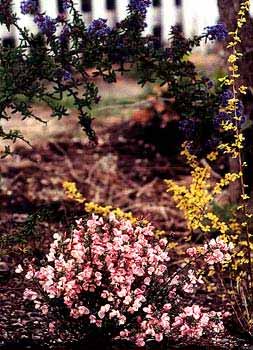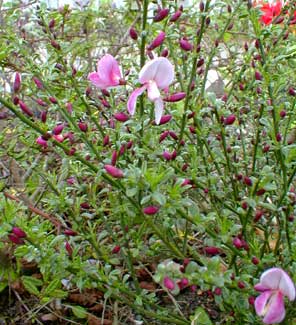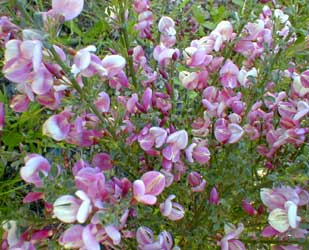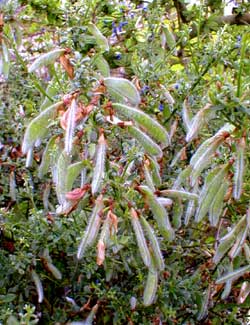 | |
| The 'Lilac Time' broom in the middle of this May 2002 portrait stands between two small shrubs it will eventually outgrow by far. To the right & farther behind the broom than perspective conveys there is Golden Japanese Barberry which is not blooming, it is the leaves that are that yellow. Hanging overhead from the left is a limb of a Ceanothus. These are planted on the street margin at the front of the driveway in pretty harsh ground intentionally under-watered. The second photo shows the same shrub in bud early in April 2004, & the third shows it on May Day in full flower. In the intervening two years it grew four times as big. | |
Cytisus scoparius x C. dallimorei 'Lilac Time'
"How lovely, Nith, thy fruitful vales,
Where bounding hawthorns gaily bloom;
And sweetly spread thy sloping dales,
Where lambkins wanton through the broom."
-Robert Burns
(1759 - 1796)
(1759 - 1796)
Plain yellow Scotch Broom (Cytisus scoparius) is an invasive weed which the government mistakenly introduced throughout America's temperate regions because of its excellent capacity to protect cleared hillsides or new embankments from erosion.
Along thousands of miles of freeways this stuff was deposited, mostly the natural yellow variety, in some places the white. It is today so extensively naturalized & troublesome that it is hard to fully appreciate its far less harmful cultivars & hybrids, such as 'Lilac Time,' which suffer a degree of prejudice by association.
Two years in a row I talked Granny Artemis out of getting any broom cultivars for the roadside, since we already do battle with the common yellow variety that springs up without invitation. But my initial prejudice was merely one of not wanting to pay a nursery price for something that seemed very like a weed I kept cutting down.
 But Granny Artemis never got over liking them, & I had to admit I had a personal fondness for brooms dating to childhood, when I cried until my great-grampa caved in & bought me a Burkwood's Broom with which I had fallen in love at age eight when I went with him to a nursery.
But Granny Artemis never got over liking them, & I had to admit I had a personal fondness for brooms dating to childhood, when I cried until my great-grampa caved in & bought me a Burkwood's Broom with which I had fallen in love at age eight when I went with him to a nursery.Early in May of 2002 Granny Artemis & I were visiting nurseries in more distant places. At one nursery we saw planted at the well-landscaped entrance a long-established purple-blooming broom about six foot by six foot. It was so densely flowered I did not at first recognize what it was.
Even in context of blooming alongside Iron Clad rhododendrons & golden-leafed spireas, that broom was the most beautiful shrub in the landscape. We hopped out of the car to look at it more closely, & I recognized it as very likely the exact broom cultivar I had had as a child, the Burkwood's that had been the first shrub I ever personally planted.
 Well, there was no longer any denying that my vetoing brooms was a foolish prejudice. Within a couple of days, Granny Artemis obtained three small cultivars for our roadside. They were just inexpensive gallon-pot sized shrubs, but they grew rapidly.
Well, there was no longer any denying that my vetoing brooms was a foolish prejudice. Within a couple of days, Granny Artemis obtained three small cultivars for our roadside. They were just inexpensive gallon-pot sized shrubs, but they grew rapidly.We obtained three varieties: Burkwood's Broom, Lena's broom, & the smallest of all, a hybrid of C. scoparius with the semi-dwarf C. dallimorei, sold as 'Lilac Time' Broom, or 'Lilac Time' False Heather.
The first photo at top was snapped the same week of May we planted our little 'Lilac Time.' The second two photos are from April & May two years later (2004). In that amount of time the original tiny shrub had more than tripled in size, yet even at that was the slowest growing of the three varieties we obtained.
 For the end of April & well into May it is densely covered with blooms of deep-lilac, pink & white, on rather "fluffy" looking green foliage distinct from other broom cultivars. The last of its flowers are spent before the end of the second week in June, when it begins to develop pea-pods. The last photo shows the shrub at the tail-end of May covered with seedpods. In three years I haven't as yet noticed any seedlings popping up anywhere, as one would with any wild broom permitted to go to seed.
For the end of April & well into May it is densely covered with blooms of deep-lilac, pink & white, on rather "fluffy" looking green foliage distinct from other broom cultivars. The last of its flowers are spent before the end of the second week in June, when it begins to develop pea-pods. The last photo shows the shrub at the tail-end of May covered with seedpods. In three years I haven't as yet noticed any seedlings popping up anywhere, as one would with any wild broom permitted to go to seed.Our little Lilac Time will eventually dominate the street corner we have it on, & will likely need regular shearing to keep it a reasonable size. It is, however, very slow-growing compared to other brooms; the 'Burkwood' by comparison was four feet tall & wide in a single year; 'Lena' was smaller than 'Burkwood' but much larger than 'Lena's Broom' after one year.
Lilac Time is not as cold hardy as other brooms & will die at five degrees F., which fortunately it never experiences in Puget Sound's mild microclimate.
It likes poor sandy soil & not much water, so we let rainfall take care of it, & almost never water it. In summer 2003 we had such a dramatic heat wave & droubt it actually did suffer some summer damage, though the other brooms weathered the drought unphased, & even the slightly more delicate 'Lilac Time' burst back to full health the following spring without effort.